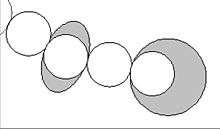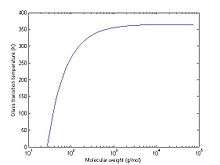Flory–Fox equation
In polymer chemistry, the Flory–Fox equation is a simple empirical formula that relates molecular weight to the glass transition temperature of a polymer system. The equation was first proposed in 1950 by Paul J. Flory and Thomas G. Fox while at Cornell University.[1] Their work on the subject overturned the previously held theory that the glass transition temperature was the temperature at which viscosity reached a maximum. Instead, they demonstrated that the glass transition temperature is the temperature at which the free space available for molecular motions achieved a minimum value.[2] While its accuracy is usually limited to samples of narrow range molecular weight distributions, it serves as a good starting point for more complex structure-property relationships.
Overview
The Flory–Fox equation relates the number-average molecular weight, Mn, to the glass transition temperature, Tg, as shown below:
where Tg,∞ is the maximum glass transition temperature that can be achieved at a theoretical infinite molecular weight and K is an empirical parameter that is related to the free volume present in the polymer sample. It is this concept of “free volume” that is observed by the Flory–Fox equation.
Free volume can be most easily understood as a polymer chain's “elbow room” in relation to the other polymer chains surrounding it. The more elbow room a chain has, the easier it is for the chain to move and achieve different physical conformations. Free volume decreases upon cooling from the rubbery state until the glass transition temperature at which point it reaches some critical minimum value and molecular rearrangement is effectively “frozen” out, so the polymer chains lack sufficient free volume to achieve different physical conformations. This ability to achieve different physical conformations is called segmental mobility.

Free volume not only depends on temperature, but also on the number of polymer chain ends present in the system. End chain units exhibit greater free volume than units within the chain because the covalent bonds that make up the polymer are shorter than the intermolecular nearest neighbor distances found at the end of the chain. In other words, chain end units are less dense than the covalently bonded interchain units. This means that a polymer sample with long chain lengths (high molecular weights) will have fewer chain ends per total units and less free volume than a polymer sample consisting of short chains. In short, chain ends can be viewed as an “impurity” when considering the packing of chains, and more impurity results in a lower Tg.

Thus, glass transition temperature is dependent on free volume, which in turn is dependent on the average molecular weight of the polymer sample. This relationship is described by the Flory–Fox equation. Low molecular weight values result in lower glass transition temperatures whereas increasing values of molecular weight result in an asymptotic approach of the glass transition temperature to Tg,∞ . The figure to the left clearly displays this relationship – as molecular weight increases, the glass transition temperature increases asymptotically to Tg,∞ (in this arbitrary case shown in the image, Tg,∞ = 365 K).
Alternative equations
While the Flory–Fox equation describes many polymers very well, it is more reliable for large values of Mn [3] and samples of narrow weight distribution. As a result, other equations have been proposed to provide better accuracy for certain polymers. For example:
This minor modification of the Flory–Fox equation, proposed by Ogawa,[4] replaces the inverse dependence on Mn with the square of the product of the number-average molecular weight, Mn , and weight-average molecular weight, Mw . Additionally, the equation:
was proposed by Fox and Loshaek,[5] and has been applied to polystyrene, polymethylmethacrylate, and polyisobutylene, among others.
However, it is important to note that despite the dependence of Tg on molecular weight that the Flory-Fox and related equations describe, molecular weight is not necessarily a practical design parameter for controlling Tg because the range over which it can be changed without altering the physical properties of the polymer due to molecular weight change is small.[3]
The Fox Equation
The Flory–Fox equation serves the purpose of providing a model for how glass transition temperature changes over a given molecular weight range. Another method to modify the glass transition temperature is to add a small amount of low molecular weight diluent, commonly known as a plasticizer, to the polymer. The presence of a low molecular weight additive increases the free volume of the system and subsequently lowers Tg , thus allowing for rubbery properties at lower temperatures. This effect is described by the Fox equation:
Where w1 and w2 are weight fractions of components 1 and 2, respectively. In general, the accuracy of the Fox equation is very good and it is commonly also applied to predict the glass transition temperature in (miscible) polymer blends and statistical copolymers. [3]
References
- ↑ Fox, T.G.; Flory, P.J. (1950), "Second-order transition temperatures and related properties of polystyrene", Journal of Applied Physics, 21: 581–591, doi:10.1063/1.1699711
- ↑ Markovitz, Hershel (May–June 1978). "Thomas G. Fox 1921–1977". Rheologica Acta. 17 (3). doi:10.1007/BF01535056.
- 1 2 3 Hiemenz, Paul; Timothy Lodge (2007). Polymer Chemistry. Boca Raton, Florida: CRC Press. ISBN 1-57444-779-3.
- ↑ Ogawa (1992), "Effects of molecular weight on mechanical properties of polypropylene", Journal of Applied Polymer Science, 1869: 44, doi:10.1002/app.1992.070441022
- ↑ Fox, T.G.; Loshaek, S. (1955), "Influence of molecular weight and degree of crosslinking on the specific volume and glass temperature of polymers", Journal of Polymer Science, 371: 15, doi:10.1002/pol.1955.120158006